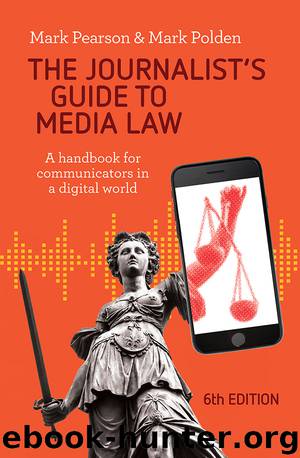The Journalist's Guide to Media Law by Mark Pearson & Mark Polden

Author:Mark Pearson & Mark Polden
Language: eng
Format: epub
Publisher: Allen & Unwin
Published: 2018-11-16T16:00:00+00:00
Schofield explained that the restaurant broiled (‘grilled’) its lobsters. The menu warned that there was a 45-minute wait for lobster:
That should really have sent the balloon up for us. Even Godzilla boiled for 45 minutes would be appallingly overcooked. Which is what our grilled lobster most certainly was, cooked until every drop of juice and joy in the thing had been successfully eliminated, leaving a charred husk of a shell containing meat that might have been albino walrus.
He continued, stating that the ‘carbonised claws contained only a kind of white powder’, describing the handling of ‘excellent fresh lobster at $25 a kilo’ as ‘close to culinary crime’.
LAW
The restaurant sued. The main imputations claimed were that the plaintiff:
• was a cruel and inhumane restaurateur in that it, by its employees, killed live lobsters by broiling them alive
• was an incompetent restaurateur in that it, by its employees, broiled lobsters for 45 minutes contrary to accepted culinary methods
• was a restaurateur that charged a price for excellent fresh lobster that, when later cooked incompetently by its employees, did not then represent good value for money
• was an incompetent restaurateur in that it, by its employees, served lobsters with charred husks of shell, meat destroyed as to quality and claws containing white powder.
The Herald and Schofield failed in their defence of fair comment. Most importantly, they were unable to prove the truth of the facts on which the opinion had been based, many of which appeared to have been exaggerated for effect. They had also eaten the evidence. The restaurant was awarded $100,000 in damages.
LESSONS FOR REVIEWERS, BLOGGERS AND OPINION WRITERS
The verdict was greeted with a hail of protest from the media, with many claiming it marked the end of the fair comment defence. The case was followed more recently by an initial win for the media in the Coco Roco case (2007), only to be overturned on appeal (2013). The first lesson is that journalists must be able to prove every fact on which they base their comments: in the Coco Roco case, reviewer Matthew Evans was able to produce his contemporaneous notes and there was additional evidence from his dining companion and back-up evidence (obtained after the defamation claim was received) from former restaurant employees.
The second lesson is that even the most careful work can be undone by a stray headline or fact box: the piece was headlined ‘Matthew Evans fails Coco Roco’, and the fact box identified each of the proprietors, who were named. The problem was that there were two separate restaurants, Coco (an expensive restaurant) and Roco (a separate, cheaper, incarnation). Matthew Evans had only dined at one of them (Coco), while the court held that the defamatory imputations referred to each of the plaintiffs in connection with their management of both.
Download
This site does not store any files on its server. We only index and link to content provided by other sites. Please contact the content providers to delete copyright contents if any and email us, we'll remove relevant links or contents immediately.
Autoboyography by Christina Lauren(4679)
Asking the Right Questions: A Guide to Critical Thinking by M. Neil Browne & Stuart M. Keeley(4576)
Dialogue by Robert McKee(3583)
Eat That Frog! by Brian Tracy(3514)
Sticky Fingers by Joe Hagan(3454)
Journeys Out of the Body by Robert Monroe(2986)
Elements of Style 2017 by Richard De A'Morelli(2945)
Annapurna by Maurice Herzog(2841)
Schaum's Quick Guide to Writing Great Short Stories by Margaret Lucke(2806)
Full Circle by Michael Palin(2772)
The Diviners by Libba Bray(2444)
The Art of Dramatic Writing: Its Basis in the Creative Interpretation of Human Motives by Egri Lajos(2414)
The Mental Game of Writing: How to Overcome Obstacles, Stay Creative and Productive, and Free Your Mind for Success by James Scott Bell(2394)
Why I Write by George Orwell(2360)
Atlas Obscura by Joshua Foer(2350)
In Patagonia by Bruce Chatwin(2271)
The Fight by Norman Mailer(2159)
The Elements of Style by William Strunk and E. B. White(2077)
Venice by Jan Morris(2051)
